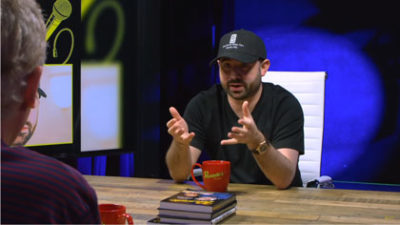Outside Scoop: Interview with Post Malone’s Producer, 6 Essential Mastering Meters, Designing Sounds for Film, and More
This week’s Outside Scoop takes a look at Post Malone’s producer Louis Bell, six essential mastering meters you need to start using, the fundamentals of designing believable sounds for film, and more. The following items on this list include some of the best content from around the web, published within the last week. Get your fix of the latest and greatest articles, videos, and podcasts for music producers, engineers, and musicians.
The Songwriter, Producer, and Composer of Post Malone’s “Rockstar”: Louis Bell
Dave Pensado interviews Louis Bell on Pensado’s Place. Bell has worked on records like Post Malone’s “Rockstar” and Sunflower,” Halsey’s “Without Me,” and Camila Cabello’s “Havana.” He explains his process of working with different vocalists, and how he uses his background as a singer to milk great performances out of artists. The interview with Bell starts at about 8 minutes and 5 seconds into the video.
10 Tips on Creative Sound Design
MusicTech’s Andy Jones offers up 10 different pieces of advice on using creative sound design to stand out amongst other artists. The list includes tips like allocating time specifically for sound design, starting with simple processing, layering sounds, sampling as you work, and more. Jones also makes the point that deconstructing synth patches made by others can lead to unique results.
How to Widen the Sweet Spot of Your Listening Room
Learn how to widen the “sweet spot” of your stereo system. The sweet spot is the area between your speakers that provides the most balanced listening experience. Paul from PS Audio walks you through the dos and don’ts of achieving a more full stereo image in this video.
How to Balance a Full-Time Day Job With Writing Music (feat. Enamour)
This week’s EDMProd podcast focuses on progressive/deep house producer Enamour. Sam Matla of EDMProd talks to him about his come up in the music industry, how he manages to find time to create music and tour while working a busy full-time day job, as well as how he approaches taking songs from start to finish.
6 Mastering Meters You Need to Learn How to Use
Learn how to use six different mastering meters to identify mix issues and improve playback quality via Black Ghost Audio’s blog. Also, learn how analyzing other artist’s songs can help you improve your masters. The meters on this list include spectrum analyzers, spectrograms, vectorscopes, phase correlation meters, level meters, and loudness meters.
The Fundamentals of Designing Sound to Picture
Ian Vargo of the Pro Audio Files offers up some very cool insight into how sounds are designed for motion pictures at a professional level. Sound designers play a considerable role in creating believable worlds within movies, and every little detail counts. Vargo discusses the importance of frames, layers, synthesis, digital instruments, and dietetic vs. non-diegetic sound.
How Does Internal Pressure Affect Speaker Performance?
Paul from PS Audio answers a fascinating question from one of his viewers, who asks about dead speaker enclosures. The viewer wants to know how internal speaker pressure is handled if there is no porting since it seems as though the enclosure will hurt driver performance. Paul discusses the differences between open baffle speakers, sealed box speakers, and speakers with a port. He also goes into detail about how servos help to regulate the power of amplifiers in woofers to ensure playback clarity.
Mike Patrick Shares The Keys to Success as a Keyboardist
Mike Patrick works as Mike Skinner’s keyboardist, and in this interview, he talks to Andy Price of MusicTech about how he got to where he is today. Patrick grew up playing piano and even started a Classical BA in music at Middlesex University. He explains how playing gigs and networking ultimately led to his success.
What Sample Rate Should You Record And Mix At?
Perhaps one of the most debated topics on music production forums, Graham Cochrane of The Recording Revolution attempts to tackle the question of “What sample rate should you record and mix at?” He provides a brief summary of what sample rate is, and then discusses when and why you should record at specific sample rates.
Charles Hoffman is a Mixing and Mastering Engineer at Black Ghost Audio. After graduating from the University of Manitoba with an English degree, Charles completed his education at Icon Collective in Los Angeles, CA.
Please note: When you buy products through links on this page, we may earn an affiliate commission.







